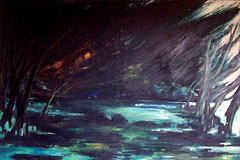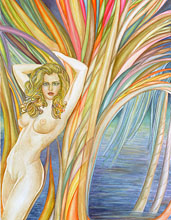| The art of Rosario Tornatore |
||
 Alluvione “Sensazione di una Realtà”, 1964 oil on canvas, 100 x 200 cm  “La Tempesta”, 1964 oil on canvas, 100 x 200 cm  Muncibèddu "Etna",1964 oil on canvas, 80 x 100 cm  “Pont des arts - Paris ”, 1967 oil on canvas, 45 x 60 cm  “Percezione Spazio Tempo”, 1969 etching+aquatint on zinc, 25 x 25 cm  “Struttura Dimensione”, 1977 oil+balsawood relief , 80 x 60 cm  “ Analogie Visibili”, 1982 oil on canvas, 30 x 35 cm  “Impenetrabile e Nascosto”, 1982 oil on canvas, 60 x 50 cm  Manifesto in occasione di “ Giornate Belliniane”, Catania 1988 tempera sketch, 55 x 35 cm  “ Il Vicino e il Lontano” Primordi, 1985 oil on canvas, 100 x 70 cm |
Art, especially painting, is an innate, instinctive passion for Rosario Tornatore, for whom the academic and university studies were a formative-cultural opportunity and an investigation into technical skills, but they didn't undermine or condition his personality and propensities - already well defined in his very nature - nor the expressive ideal present in embryonic form then developed over time. The sixties were a period characterised by numerous outside influences, deriving from the lively artistic habitats of the European capitals, where the artist lived, studied and worked. He works in his own dimension, learning from other experiences and observing the complex value of a memory, without which the present reality isn't conceivable, arriving at outcomes that are absolutely unique to him. The colour heats up, tending towards bright shades, browns and certain soft, frayed lights. In a precise rhythmic of shapes, in turn (and as always) containing and revealing declarative signs of echoes. Of all the artists he's met, Picasso is the one who definitely left a deep, stimulating and indelible mark on Tornatore. Examining Tornatore's drawings and gouache paintings with his famous heavy manner, one of his comments was that this style of painting was real, not attempting to mimic other artists or masters fashionable at that time (not even Picasso himself). He told Tornatore not to follow the example of so many young people, who expected to imitate his works without ever having learnt to paint like the masters of the Renaissance, but to continue in his research that was already clearly directed towards the “light of colour”. Another important meeting, again in Paris, was that with the painter Koler Samos who, recently arrived in the French capital after abandoning the management of the Academy of Prague for political reasons, organised a personal exhibition for him at the Carpentier Gallery. Koler Samos himself, in the presentation of the catalogue, emphasised: “… unlike the Flemish painters, who moved south to master a luminosity in their otherwise dark, unsettling colours, Tornatore - already a natural master of Mediterranean light - looks to the north for covert, suffused tones that almost capture and dim the brightness”. In 1970 the artist was attracted to the artistic environment of one of the most culturally representative Italian cities, Venice. He decided to move there, to attend the Centro Internazionale della Grafica, where his works would later be on permanent display. This stay allowed him to strike up friendships of notable importance for his artistic sensitivity, for example with the painters Virgilio Guidi and Leone Minassian, and the critics Toni Toniato, Giuseppe Marchiori, Enrico Buda, Silvio Branzi, Enzo Di Martino and Umbro Apollonio. The early style of Tornatore's art was therefore based on figurative forms linked to historical expressionism; a pretext to manifest his emotional sensations and spiritual messages. In 1965 he moved from Rome (the city where he'd lived and studied for a long time) to Paris (where he was to remain until 1970), and continued painting in his expressionist style. His subjects of inspiration were the city itself with its bridges, streets and houses, as well as the French countryside. These forms gradually changed, becoming less subjective, like those of the New Figuration. His message, made up of images and sensations, couldn't fail to mirror the world with the social problems characterising it at that time: we're at the height of ’68. This is how the figurative element of his compositions grew smaller and smaller, until it disappeared completely and gave way to optical-psychological geometric compositions. Abstract experience consequently brought out the essential complexity of the artist. Shapes, colours, divisions, creativity, and the option for a symbolic value of the orchestration of meanings - these all led him to look both around and within himself. As if those truths and realities were – and for him they are – nothing other than the resurfacing of a process of analysis and sedimentation. It's now a question of conversing with spatiality, and it will be a memory destined not to evaporate over the years; on the contrary, the measured and rising articulation, together with the bright, Mediterranean colours, anticipate the structures organised in natural-gothic architecture in the works of the coming years. Between 1979 and 1983, the abstract moves back towards less geometric, structural forms, adopting a movement that gradually begins to draw out and recall the figurative motifs. The experience of abstractionism is naturally present in the brushstrokes and the shades of colour, revealing a search for chromaticity that characterises the works of this period. Colour becomes the primary element, essential for both the research and, at the same time, for a psychological and symbolic expression. It becomes the opportunity to create harmony and bright, surreal plants; a web of reeds emerging from the water… the primordial symbol of life. The pictorial expression of the 1980s recaptures the figurative period, no longer expressionist but moving towards all that is surreal and imaginary. The means of expression is his own personal style, emerging as the need to express specific symbolic and esoteric messages; it contains the metamorphosis, gradual growth and constant search for inner perfection. His studies and experience as a stage designer in 1960s Rome, then in Paris and Catania, re-emerge in the creation of pictorial works that add considerable meaning to the organisation of space, where the plastic 3-dimension aspect leads to an allusion that can be seen as existential. This decade is particularly important for Tornatore's painting; the artist works quickly in these years, and his creations show constant transformations, as if they were stimulated by an insatiable frenzy aimed at straying from the tangible world into places that are humanly and physically non-existent. They reveal a sort of representationalism extremely far from the classic one. This is the start of a certain all-embracing conception of space, formulated for those rhythms that identify and indicate the existence of a construction that will be fundamental in the painter's image and imagery in the near future. The language becomes symbolic in the true sense and, in some cases, with explicit references, while in other paintings it introduces a sort of obscurity. The appearance of the image breaks up and is replaced - via a precise search - by a sign-articulated composition. Signs for which it's not entirely rash to assume that an intimate conscience persisted in Tornatore's spirituality, arriving at the theory of a reality, albeit diminished. A reality that doesn't live if not for an absolute subjectiveness and, as such, transforms and summarises in a real, precisely symbolic evocation, introducing analyses that direct their potential towards the suggestions of a truth. And this is because even in the most autonomous images (we mean self-sufficient, if not cryptic), it seems there is always a sort of subtended relationship with a possible truth. Nevertheless, Rosario Tornatore's work can be enjoyed by the public, whatever the technique used to create it, and it is the matured result of an engrossing introspection. For this reason, the artist often feels the need to get away from the rest of the world; to listen to his inner voice and give it body, shape and colour; to outline the symbols and messages that the worldly hubbub covers; to look into the depths of his soul and tap every shade of the emotions, feelings and sensations lying there. It's in the 1990s that we see in Rosario Tornatore's work the beginning of a new and definitive assertion of his pictorial idiom, still susceptible to transformations and searching for a formal, chromatic perfection. The subsequent images live via their own syntax, and also bear witness to a sort of tone outpouring, ever more incisive and personal. |
|
 “ La Sapienza Santa”, 1995 oil on canvas, 100 x 70 cm |
 “Favole di Realtà Metafisiche”, 1999 watercolour, 76 x 56 cm |
|
 “ Vibrazioni Magnetiche”, 2002 mixed technique on canvas, 122 x 122 cm |
|
|||||||||||||||